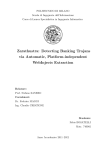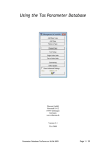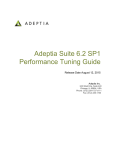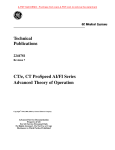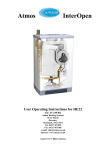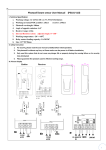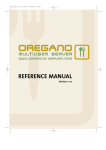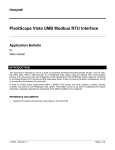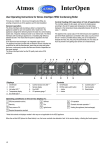Download HCP Tool User`s Manual
Transcript
‘HCP Tool’ - User’s Manual [Release 1.0.8] HCP Tool User’s Manual Release 1.0.8 HCP Tool Users Manual.odt [email protected] page 1 2012-03-06 ‘HCP Tool’ - User’s Manual [Release 1.0.8] License The MIT License (MIT) Copyright (c) 2012 Thorsten Simons ([email protected]) Permission is hereby granted, free of charge, to any person obtaining a copy of this software and associated documentation files (the "Software"), to deal in the Software without restriction, including without limitation the rights to use, copy, modify, merge, publish, distribute, sublicense, and/or sell copies of the Software, and to permit persons to whom the Software is furnished to do so, subject to the following conditions: The above copyright notice and this permission notice shall be included in all copies or substantial portions of the Software. THE SOFTWARE IS PROVIDED "AS IS", WITHOUT WARRANTY OF ANY KIND, EXPRESS OR IMPLIED, INCLUDING BUT NOT LIMITED TO THE WARRANTIES OF MERCHANTABILITY, FITNESS FOR A PARTICULAR PURPOSE AND NONINFRINGEMENT. IN NO EVENT SHALL THE AUTHORS OR COPYRIGHT HOLDERS BE LIABLE FOR ANY CLAIM, DAMAGES OR OTHER LIABILITY, WHETHER IN AN ACTION OF CONTRACT, TORT OR OTHERWISE, ARISING FROM, OUT OF OR IN CONNECTION WITH THE SOFTWARE OR THE USE OR OTHER DEALINGS IN THE SOFTWARE. HCP Tool Users Manual.odt [email protected] page 2 2012-03-06 ‘HCP Tool’ - User’s Manual [Release 1.0.8] Summary While working with Hitachi Content Platform (HCP), some challenges may come up that are not easy to address without additional tools. Think of a customer who has created some directories and objects while playing around with a newly acquired HCP – how to get rid of them? Objects are somewhat easy deletable through the Namespace browser (if he played with an authenticated namespace), but what about directories? Or think of a customer who has several million objects ingested into HCP, now getting aware that he should have set a retention for these objects! How to change a million objects retention? No way with HCP alone. Or think of a Proof of Concept situation – we need to showcase ingestion, reading and possibly deletion of objects into/within HCP. If it’s more then CIFS or NFS access and we don’t have an application to be tested with HCP, it’s not that easy with HCP alone. This is where ‘HCP Tool’ steps in. As a command-line-tool, it offers functions to… Calculate the access token needed to access an authenticated namespace or the Management API Load HCP with test data List the content of a namespace (or parts of it) Change the retention of objects within HCP Delete objects from HCP, supporting Purge and Privileged Delete Warning: some commands may have severe impact on a production HCP: load - if you load data into a namespace running in ‚compliance‘ mode while setting a retention for the ingested objects, you will not be able to delete these objects before the retention has expired! retention - you might lock data in longer retention then wanted if you use a nincorrect retention string - please refer to ‚Using a Namespace‘ on how to form this string! unload - you might delete (purge) objects under retention in a namespace in ‚enterprise‘ mode. HCP Tool Users Manual.odt [email protected] page 3 2012-03-06 ‘HCP Tool’ - User’s Manual [Release 1.0.8] Preparing for use Find the right server/workstation for ‘HCP Tool’ to be run on Don’t run ‘HCP tool’ on a server running customer’s production! Under certain circumstances it may overload the server in terms of memory and cpu cycles, slowing down or killing other applications! Always use a server/workstation that has no impact to the customers business. Make sure the server/workstation has network access to HCP! Switch off the local DNS cache! c:> net stop dnscache This will allow ‘HCP Tool’ to make use of HCPs load balancing mechanism! If possible, lower MS Windows’ socket timeout parameter! See Appendix B for a description on how to do that. Installation on Linux HCP Tool needs an installation of Python, at least version 3.2.1. Download the latest pre-compiled release of HCP Tool for Linux (hcpt_1.0.8.precomp.tar) from: http://sourceforge.net/p/hcptool/wiki/Home You do not need to be ‚root‘ for the next steps, unless you want to enable all users to use HCP Tool on this server. o Unpack the tarball into a directory of your choice: sm@linux64:~> mkdir hcpt; cd hcpt sm@linux64:~/hcpt> tar -xvf hcpt_x.y.z.precomp.tar o Check for function: sm@linux64:~/hcpt> python hcpt.pyc --version HCP Tool Users Manual.odt [email protected] page 4 2012-03-06 ‘HCP Tool’ - User’s Manual [Release 1.0.8] Installation on MS Windows Download the latest release of ‚HCP Tool‘ (HCP Tool x.y.z (xxxx).exe) from: http://sourceforge.net/p/hcptool/wiki/Home. Install it by running HCP Tool x.y.z (xxxx).exe: (The installer will add the path to the executable file to the PATH environment variable.) HCP Tool Users Manual.odt [email protected] page 5 2012-03-06 ‘HCP Tool’ - User’s Manual [Release 1.0.8] Verify the Installation Make sure that you have access to an HCP system and valid user credentials for an authenticated namespace at hand. The test may also be run against the default namespace, where’s no need to have user credentials (simply provide random user / password). Open a Command-line Windows (cmd.exe) If ever possible, switch of the local machine’s DNS cache: c:> net stop dnscache Run the ‘HCP Tool’ in test mode: c:> hcpt -i5 --user <user> --password <password> test --cluster \ ns.tenant.hcp.vm.loc --dir /rest/hcpt_test --file <filename> --structure 10 100 (if the target namespace has ‘versioning’ eabled, add --versionedNS to the command above!) ‘HCP Tool’ (hcpt.exe) will… 1. calculate access tokens for both namespace and 2. MAPI access 3. feed file <filename> 100 times in each of 10 subdirectories of /rest/hcpt_test within namespace ‘ns’ in tenant ‘tenant’ within an HCP with a DNS name of ‘hcp.vm.loc’ 4. discover a list of all objects and directories, beginning at /rest/hcpt_test. This list will be provided as 2 files: hcpt_test.csv (to be loaded into MS Excel) and hcpt_list.<timestamp>.db, a Sqlite3-database that will be used as base for the nexts steps. 5. update the database file with a new retention setting to be processed in the next step. 6. update HCP with the new retention settings for the objects selected in the database in the prior step. 7. delete (purge) all the objects and the directories where they have been stored. At the end, there will be a logfile (hcp_test.log) showing all the output that has been showed on the screen, an Excel-importable file (hcp_test.csv) conaining a list of all objects and directories found in 4. and two Sqlite3 database files, containing the results of 4. and 7. (See Appendix A for an example) HCP Tool Users Manual.odt [email protected] page 6 2012-03-06 ‘HCP Tool’ - User’s Manual [Release 1.0.8] General usage When installed, ‘HCP Tool’ can be used by running the file ‘hcpt.exe’. It takes some arguments, telling it what to do. You can always get some help by running hcpt --help (or: hcpt ‘subcommand’ --help) The syntax is: C:> hcpt [common arguments] subcommand [subcommand arguments] common arguments are valid for all subcommands -h, --help show help and exit --version show program's version number and exit -u USER, --user USER data access acount -p PASSWORD, --password PASSWORD password (will require manual input if not given) -l LOGFILE, --logfile LOGFILE logfile (defaults to 'hcpt_subcmd.log') -i seconds, --loginterval seconds logging interval (defaults to 10 sec.) -t '# of threads', --threads '# of threads' no. of parallel threads (defaults to 30) --nossl use http instead of https -v verbosity (-v = INFO, -vv = DEBUG, -vvv = garbage collection statistics) --gc t1.t2.t3 garbage collection thresholds (defaults to '700.10.10' - see 'http://docs.python.org/py3k/library/gc.html#gc.set_threshold') subcommands are cookie load list retention test unload calculate HCP access token load bulk testdata into HCP list HCP content change retention setting for selected objects test-run all the subcommands delete content from HCP subcommand arguments are described below HCP Tool Users Manual.odt [email protected] page 7 2012-03-06 ‘HCP Tool’ - User’s Manual [Release 1.0.8] Subcommands cookie - calculate HCP access token Calculate the HCP access token to be used in http-requests. usage: hcpt cookie [-h] [--version] {daac,mapi} positional arguments: {daac,mapi} account type (DataAccessACount or MAPI) optional arguments: -h, --help show this help message and exit --version show subfunctions version and exit Example: C:> hcpt --user max --password meier cookie daac hcp-ns-auth=bWF4:7a3bbfa99f014f41f2a4b368391c092c load - load bulk testdata into HCP Perform bulk data ingestion into HCP for testing (!) purposes. usage: hcpt load [-h] [--version] -c CLUSTER -d directory -f ingestfile [-r retention_string] --structure # [# ...] optional arguments: -h, --help show this help message and exit --version show subfunctions version and exit -c CLUSTER, --cluster CLUSTER target namespace (full qualified DNS-name) -d directory, --dir directory target directory ('/rest/...' or '/fcfs_data/...') -f ingestfile, --file ingestfile file to be ingested -r retention_string, --retention retention_string retention (requires valid HCP retention string) --structure # [# ...] directory structure to be build Controlled by '--structure [#_of_dirs [#_of_dirs [...]]] #_of_files', a directory structure is build and '#_of_files' copies of 'ingestfile' will be ingested into each lowest level directory. Example: '3 3 3' causes three directories to be created below 'targetdir' (0000, 0001, 0002), with another three subdirectories (0000, 0001, 0002) in each of them and three copies of 'ingestfile' to be written into each of these subdirectories. Be cautious, you could use up a lot of capacity in HCP and generate a lot of network trafic while using it... Example: C:> hcpt --user ns1 --password ns101 -v -i3 load --cluster ns1.matrix.hcp1.vm.local \ --dir /rest /hcpt_test1 --file c:\hitachi_logo.txt --structure 10 10 1 HCP Tool Users Manual.odt [email protected] page 8 2012-03-06 ‘HCP Tool’ - User’s Manual [Release 1.0.8] list - list HCP content Discover all objects in a given subdirectory within an HCP namespace while discovering the directory tree top/down. List the found objects and directories in a MS Excel usable file (*.csv) and in a Sqlite3 database file. usage: hcpt list [-h] [--version] -c CLUSTER -d directory [--all] [-B DATABASE] [--fatDB] [--keepDB] [--QF queuesize] [--Qdb queuesize] [--delay milliseconds] [--outfile OUTFILE] [--nooutfile] [--showThreads] optional arguments: -h, --help show this help message and exit --version show subfunctions version and exit -c CLUSTER, --cluster CLUSTER target namespace (full qualified DNS-name) -d directory, --dir directory target directory ('/rest/...' or '/fcfs_data/...') --all find deleted objects, too (if versioning is configured for the namespace) -B DATABASE, --database DATABASE database file (defaults to 'hcpt_list.<timestamp>.[fat|slim].sqlite3') --fatDB include all available information in database --keepDB do not delete the database file when finished --QF queuesize defines the allowed no. of items in FindQueue --Qdb queuesize defines the allowed no. of items in dbWriterQueue --delay milliseconds add a delay (pause) in ms between two requests executed against HCP by a single thread --outfile OUTFILE filename for the resulting .csv file (defaults to 'hcpt list.csv') --nooutfile don't write an outfile, but keep database --showThreads show info about running threads Be aware: when discovering large directory trees, memory usage might become a problem, up to the point where this program might hang or even crash. You should monitor it by using '-v' or even '-vvv'. Best advice is to limit the number of threads (-t) to not more than 50 and limit the queues (--QF and --Qdb) to 10.000 and 20.000 respectively. You might encounter a deadlock situation, where "--QF" will be at max. and no object will be found. In this case, you'll need to unlimit '--QF' and maybe lower the threads. Speeding up the garbage collection by tuning '--gc' might help, too. But take care: this program might grab as many main memory as available, potentially affecting other applications - it's up to you to monitor that! Expect long (and I mean: really long) run times when discovering multimillion object directory trees! If you'd like to work with the database generated by this program, you could use tools provided at 'http://www.sqlite.org/download.html'. The Windows distribution provides an executable database shell (sqlite3.exe) in the installation folder. Example: C:> hcpt --user ns1 --password ns101 -v -i3 list --cluster ns1.matrix.hcp1.vm.local \ --dir /rest/hcpt_test1 HCP Tool Users Manual.odt [email protected] page 9 2012-03-06 ‘HCP Tool’ - User’s Manual [Release 1.0.8] retention - change retention setting for selected objects Takes a database generated by 'hcpt list' as input to update the retention setting of the objects listed in the database. After generating the database with ‘hcpt list’, the field ‘flist.new_ret’ must be updated with the new retention setting for each object (see description below). usage: hcpt retention [-h] [--version] -B DATABASE [--delay DELAY] optional arguments: -h, --help show this help message and exit --version show subfunctions version and exit -B DATABASE, -database DATABASE database file generated by 'hcp list' and altered as described below --delay DELAY add a delay (pause) in ms between two requests executed against HCP by a single thread To alter the database, you could use 'sqlite3.exe', provided in the installation folder of this tool. For example, if your database file is called 'hcplist.sqlite3' and you want to add 1 year to every object’s retention, you could follow these steps prior to running this tool: ... c:\> sqlite3 hcplist.sqlite3 sqlite> UPDATE flist SET new_ret='R+1y' WHERE type='file' OR type='object'; sqlite> .quit ... It is YOUR responsibility to specify a valid retention string 1 - ‘HCP Tool’ will not check it for validity!!! Example: c:> hcpt --user ns1 --password ns101 -v -i3 retention --database hcplist.sqlite3 test - test-run all the subcommands Runs all subcommands agains HCP, making sure that the program works. usage: hcpt test [-h] [--version] -c CLUSTER -d directory -f ingestfile [-r retention_string] --structure # [# ...] optional arguments: -h, --help show this help message and exit --version show subfunctions version and exit -c CLUSTER, --cluster CLUSTER target namespace (full qualified DNS-name) -d directory, --dir directory target directory ('/rest/...' or '/fcfs_data/...') -f ingestfile, --file ingestfile file to be ingested -r retention_string, --retention retention_string retention (defaults to 'N+1s') --structure # [# ...] directory structure to be build Example (see section ‘Verify the Installation’): c:> hcpt -i5 --user <user> --password <password> test --cluster \ ns.tenant.hcp.vm.loc --dir /rest/hcpt_test --file <filename> --structure 10 100 1 See HCP's manual‚Using a Namespace‘ on how to form a valid retention string. HCP Tool Users Manual.odt [email protected] page 10 2012-03-06 ‘HCP Tool’ - User’s Manual [Release 1.0.8] unload - delete content from HCP Perform deletion of data within HCP namespaces by discovering a directory tree top/down (alternatively, a list with objects to be deleted can be provided). Will find all directories and objects within that tree and will imediately begin with object deletion right after one has been found. Directory deletion will start down/up when the whole tree has been discovered. It will write a sqlite3 database file with a single record for each directory and object found, containing all the information available for it. This can grow quite large... usage: hcpt unload [-h] [--version] -c CLUSTER -d directory [--infile INFILE] [-B DATABASE] [--fatDB] [--keepDB] [--QF queuesize] [--Qdb queuesize] [--objonly] [--purge] [--privileged REASON] [--YES] optional arguments: -h, --help show this help message and exit --version show subfunctions version and exit -c CLUSTER, --cluster CLUSTER target namespace (full qualified dns-name) -d directory, --dir directory target directory (/rest/... or /fcfs_data/...) --infile INFILE file holding a list of objects to be deleted (full path: '/rest/.../object' or '/fcfs_data/.../object'. If set, '--dir' will be used to determine the type of namespace, only. -B DATABASE, --database DATABASE database file (defaults to 'hcpt_list.<timestamp>.[fat|slim].sqlite3') --fatDB include all available information in database --keepDB do not delete the database file when finished --QF queuesize size of internal queue (defaults to unlimited) --Qdb queuesize defines the allowed no. of items in dbWriterQueue --objonly do not delete directories --versionedNS set this if target namespace has versioning enabled --purge purge versions (if not set, directory deletion will fail if versioning is enabled) --privileged REASON perform privileged delete (requires a 'reason') --YES ...if you really (!) want to delete the found objects/directories (defaults to 'generate a list of objects/directories only') Be aware: if you have directories with a huge number (10.000++) of objects, main memory will become excessive used, even more the more threads you use. This could lead to runtime errors - in this case you will need to serialize the processing by limiting the number of threads down to 1 (one) depending on the available main memory. Of course, this will lead to a much longer runtime - monitor the processing by using the commandline switch '-v'. Example: c:> hcpt --user ns1 --password ns101 -v -i3 unload --cluster \ ns1.matrix.hcp1.vm.local --dir /rest/hcpt_test1 --YES HCP Tool Users Manual.odt [email protected] page 11 2012-03-06 ‘HCP Tool’ - User’s Manual [Release 1.0.8] Appendix A Example logfile from ‘hcpt test’ 07/05 07/05 07/05 07/05 07/05 07/05 07/05 07/05 07/05 07/05 07/05 07/05 07/05 07/05 07/05 07/05 07/05 07/05 07/05 07/05 07/05 07/05 07/05 07/05 07/05 07/05 07/05 07/05 07/05 07/05 07/05 07/05 07/05 07/05 07/05 07/05 07/05 07/05 07/05 07/05 07/05 07/05 07/05 07/05 07/05 07/05 07/05 07/05 07/05 07/05 07/05 07/05 07/05 07/05 07/05 07/05 07/05 07/05 07/05 07/05 07/05 07/05 07/05 07/05 07/05 07/05 07/05 10:36:46 10:36:46 10:36:46 10:36:46 10:36:46 10:36:46 10:36:46 10:36:46 10:36:46 10:36:46 10:36:46 10:36:46 10:36:46 10:36:46 10:36:46 10:36:46 10:36:46 10:36:46 10:36:46 10:36:46 10:36:46 10:36:46 10:36:46 10:36:46 10:36:46 10:36:46 10:36:46 10:36:46 10:36:46 10:36:46 10:36:46 10:36:46 10:36:46 10:36:46 10:36:51 10:36:56 10:37:01 10:37:06 10:37:11 10:37:11 10:37:11 10:37:11 10:37:11 10:37:11 10:37:11 10:37:11 10:37:11 10:37:11 10:37:11 10:37:11 10:37:11 10:37:11 10:37:11 10:37:11 10:37:11 10:37:11 10:37:11 10:37:11 10:37:11 10:37:11 10:37:11 10:37:11 10:37:11 10:37:11 10:37:11 10:37:11 10:37:11 [INFO [INFO [INFO [INFO [INFO [INFO [INFO [INFO [INFO [INFO [INFO [INFO [INFO [INFO [INFO [INFO [INFO [INFO [INFO [INFO [INFO [INFO [INFO [INFO [INFO [INFO [INFO [INFO [INFO [INFO [INFO [INFO [INFO [INFO [INFO [INFO [INFO [INFO [INFO [INFO [INFO [INFO [INFO [INFO [INFO [INFO [INFO [INFO [INFO [INFO [INFO [INFO [STARTUP [STARTUP [STARTUP [STARTUP [STARTUP [STARTUP [STARTUP [STARTUP [STARTUP [STARTUP [STARTUP [STARTUP [STARTUP [STARTUP [STARTUP HCP Tool Users Manual.odt [email protected] ] ] ] ] ] ] ] ] ] ] ] ] ] ] ] ] ] ] ] ] ] ] ] ] ] ] ] ] ] ] ] ] ] ] ] ] ] ] ] ] ] ] ] ] ] ] ] ] ] ] ] ] ] ] ] ] ] ] ] ] ] ] ] ] ] ] ] hcpt test v.0.9.2 (2011-07-05/Sm) Logfile: hcpt_test.log Target: https://ns1.matrix.hcp1.vm.local/rest/hcpt_test DataAccAcnt: ns1 Ingestfile: c:\hitachi_logo.txt Started at: Tue, 05.07., 10:36:46 ===================================================== ------------------------------------------------Test 1: generate a cookie for a DataAccessAccount ------------------------------------------------hcp-ns-auth=bnMx:780c3adf708201cbe71f9a9594bdf12c ----------------------------------------Test 2: generate a cookie for MAPI access ----------------------------------------hcp-api-auth=bnMx:780c3adf708201cbe71f9a9594bdf12c ---------------------------------Test 3: load some objects into HCP ---------------------------------hcpt load v.1.0.6 (2011-06-29/Sm) Logfile: hcpt_test.log Loginterval: 5 sec. Target: https://ns1.matrix.hcp1.vm.local/rest/hcpt_test/ DataAccAcnt: ns1 Ingestfile: c:\hitachi_logo.txt Filesize: 2051 Bytes (= 2.00 Kbyte) Retention: 0 Structure: [10, 100] = 1,000 PUTs (= 1.96 Mbyte) Threads: 30 Started at: Tue, 05.07., 10:36:46 -------------------------------------------------MonitorThread started monitoring Worker.Qbox.qsize() files sent: 161, errors: 0, PUTs/sec.: 32.1 files sent: 441, errors: 0, PUTs/sec.: 44.0 files sent: 675, errors: 0, PUTs/sec.: 44.9 files sent: 934, errors: 0, PUTs/sec.: 46.7 files sent: 1000, errors: 0, PUTs/sec.: 40.0 MonitorThread exits on Worker.Qbox.qsize() == 0 -------------------------------------------------Started at: Tue, 05.07., 10:36:46 Ended at: Tue, 05.07., 10:37:11 Runtime: 25.03 Sekunden Success: 1000 Errors: 0 Obj./Sec.: 39.9 Transfer: 80.01 Kbyte/sec. ------------------------------------Test 4: list the newly fed-in objects ------------------------------------hcpt list v.1.2.7 (2011-06-29/Sm) Logfile: hcpt_test.log Loginterval: 5 sec. Database: hcpt_list.20110507103646.db (will be kept when finished) (will include deleted objects) Target: https://ns1.matrix.hcp1.vm.local/rest/hcpt_test OutFile: hcpt_test.csv DataAccAcnt: ns1 Threads: 30 FindQue: -1 dbWriterQue: -1 Verbosity: 1 Started at: Tue, 05.07., 10:37:11 ------------------------------------------------------------------------------- page 12 2012-03-06 ‘HCP Tool’ - User’s Manual 07/05 07/05 07/05 07/05 07/05 07/05 07/05 07/05 07/05 07/05 07/05 07/05 07/05 07/05 07/05 07/05 07/05 07/05 07/05 07/05 07/05 07/05 07/05 07/05 07/05 07/05 07/05 07/05 07/05 07/05 07/05 07/05 07/05 07/05 07/05 07/05 07/05 07/05 07/05 07/05 07/05 07/05 07/05 07/05 07/05 07/05 07/05 07/05 07/05 07/05 07/05 07/05 07/05 07/05 07/05 07/05 07/05 07/05 07/05 07/05 07/05 07/05 07/05 07/05 07/05 07/05 07/05 07/05 07/05 07/05 07/05 07/05 07/05 07/05 07/05 10:37:11 10:37:11 10:37:11 10:37:11 10:37:16 10:37:16 10:37:16 10:37:16 10:37:16 10:37:16 10:37:16 10:37:16 10:37:16 10:37:16 10:37:16 10:37:16 10:37:16 10:37:16 10:37:16 10:37:16 10:37:16 10:37:16 10:37:16 10:37:16 10:37:16 10:37:16 10:37:16 10:37:16 10:37:16 10:37:16 10:37:16 10:37:16 10:37:16 10:37:16 10:37:16 10:37:16 10:37:16 10:37:16 10:37:21 10:37:26 10:37:28 10:37:31 10:37:31 10:37:31 10:37:31 10:37:31 10:37:31 10:37:31 10:37:31 10:37:31 10:37:31 10:37:31 10:37:31 10:37:31 10:37:31 10:37:31 10:37:31 10:37:31 10:37:31 10:37:31 10:37:31 10:37:31 10:37:31 10:37:31 10:37:31 10:37:31 10:37:31 10:37:31 10:37:31 10:37:31 10:37:31 10:37:36 10:37:41 10:37:44 10:37:45 [INFO ] [INFO ] [INFO ] [INFO ] [INFO ] [INFO ] [INFO ] [INFO ] [STOPDOWN] [STOPDOWN] [STOPDOWN] [STOPDOWN] [STOPDOWN] [STOPDOWN] [STOPDOWN] [INFO ] [INFO ] [INFO ] [INFO ] [INFO ] [INFO ] [INFO ] [INFO ] [INFO ] [INFO ] [INFO ] [STARTUP ] [STARTUP ] [STARTUP ] [STARTUP ] [STARTUP ] [STARTUP ] [STARTUP ] [STARTUP ] [STARTUP ] [STARTUP ] [INFO ] [INFO ] [INFO ] [INFO ] [INFO ] [INFO ] [INFO ] [STOPDOWN] [STOPDOWN] [STOPDOWN] [STOPDOWN] [STOPDOWN] [STOPDOWN] [STOPDOWN] [INFO ] [INFO ] [INFO ] [INFO ] [STARTUP ] [STARTUP ] [STARTUP ] [STARTUP ] [STARTUP ] [STARTUP ] [STARTUP ] [STARTUP ] [STARTUP ] [STARTUP ] [STARTUP ] [STARTUP ] [STARTUP ] [STARTUP ] [WARNING ] [INFO ] [WARNING ] [INFO ] [INFO ] [WARNING ] [INFO ] HCP Tool Users Manual.odt [email protected] [Release 1.0.8] *** monitor started *** *** dbWriter started *** *** Discovery finished after 00:00:00.48 *** *** dbWriter finished after 00:00:00.55*** Dirs:11; Objs:1,000; Err/Warn:0/0; dbWrites:1,011 [QF:0; Qdb:0] *** monitor exits *** *** writing outfile 'hcpt_test.csv' *** *** finished writing outfile 'hcpt_test.csv' after 00:00:00.2 *** ------------------------------------------------------------------------------Started at: Tue, 05.07., 10:37:11 Ended at: Tue, 05.07., 10:37:16 Runtime: 00:00:05.5 h:m:s.ms Found: 11 Directories, 1,000 Objects Warnings: 0 Errors: 0 ------------------------------------------------------Test 5: prepare the database file for retention changes ------------------------------------------------------*** database update begins *** *** changing all object's retention to 'N+1s' *** *** database update finished *** -------------------------------------------------------Test 6: change the retention of the newly fed-in objects -------------------------------------------------------hcpt retention v.0.9.5 (2011-07-02/Sm) Logfile: hcpt_test.log Loginterval: 5 sec. Database: hcpt_list.20110507103646.db (1.2.7/2011-06-29/Sm) Target: https://ns1.matrix.hcp1.vm.local DataAccAcnt: ns1 Threads: 30 Verbosity: 1 Started at: Tue, 05.07., 10:37:16 ------------------------------------------------------------------------------*** monitor started *** *** Changing retentions started *** Changed: 427, Errors=0, Warnings=0 Changed: 825, Errors=0, Warnings=0 *** Changing retentions finished after 00:00:12.71 *** Changed: 1,000, Errors=0, Warnings=0 *** monitor exits *** ------------------------------------------------------------------------------Started at: Tue, 05.07., 10:37:16 Ended at: Tue, 05.07., 10:37:31 Runtime: 00:00:15.3 h:m:s.ms Changed: 1000 Warnings: 0 Errors: 0 --------------------------------------Test 7: delete the newly fed-in objects --------------------------------------hcpt unload v.1.1.8 (2011-07-04/Sm) Logfile: hcpt_test.log Loginterval: 5 sec. Database: hcpt_unload.20110507103646.db (will be kept when finished) Target: https://ns1.matrix.hcp1.vm.local/rest/hcpt_test DataAccAcnt: ns1 Threads: 30 QueueSize: -1 Purge: yes Verbosity: 1 DeleteMode: REQUESTED - Objects and Directories Started at: Tue, 05.07., 10:37:31 ------------------------------------------------------------------------------MonitorThread started - monitoring Worker Threads *** dbWriter started *** ***Discovery finished*** Dirs: 11/0, Objects: 1000/265 (found/deleted), Errors: 0 [Q:0/705/0 (find/del/dbW)] Dirs: 11/0, Objects: 1000/723 (found/deleted), Errors: 0 [Q:0/247/0 (find/del/dbW)] ***Object deletion finished*** Thread-132: http (DELETE) error: 403:/rest/hcpt_test (re-scheduled for later deletion) page 13 2012-03-06 ‘HCP Tool’ - User’s Manual 07/05 07/05 07/05 07/05 07/05 07/05 07/05 07/05 07/05 07/05 07/05 07/05 07/05 07/05 07/05 10:37:45 10:37:46 10:37:46 10:37:46 10:37:46 10:37:46 10:37:46 10:37:46 10:37:46 10:37:46 10:37:46 10:37:46 10:37:46 10:37:46 10:37:46 [WARNING ] [INFO ] [WARNING ] [STOPDOWN] [STOPDOWN] [STOPDOWN] [STOPDOWN] [STOPDOWN] [STOPDOWN] [STOPDOWN] [INFO ] [INFO ] [INFO ] [INFO ] [INFO ] HCP Tool Users Manual.odt [email protected] [Release 1.0.8] ***Directory deletion finished*** Dirs: 11/11, Objects: 1000/1000 (found/deleted), Errors: 0 [Q:0/0/0 (find/del/dbW)] MonitorThread exits - all Worker Threads ended ------------------------------------------------------------------------------Started at: Tue, 05.07., 10:37:31 Ended at: Tue, 05.07., 10:37:46 Runtime: 15.03 Sekunden Found: 11 Directories, 1000 Objects Deleted: 11 Directories, 1000 Objects Errors: 0 ===================================================== Started at: Tue, 05.07., 10:36:46 Ended at: Tue, 05.07., 10:37:46 Runtime: 60.26 Sekunden page 14 2012-03-06 ‘HCP Tool’ - User’s Manual [Release 1.0.8] Appendix B If ‚ HCP Tool‘ is used effectively, it may send many requests per second to HCP. This may lead to ‚10048 - Address already in use‘ errors. This happens because Windows doesn’t release used (and closed) TCP/IP-scockets until a timeout of 240 seconds (default) has elapsed. This adds to the fact, that the nummer of outgoing TCP/IP-ports is limited to less than 4.000. Taken as fact that every socket needs it’s own outgoing port, it get’s clear that we will run out of free sockets when doing multi-ten requests per second. ‘HCP Tool’ catches the described error, waits a second and then tries again - but that’s just a workaround slowing down the process substantially. This can be fixed by: lowering the „TCP/IP socket connection timeouts“ from 240 seconds (default) to e.g. 30 seconds. A Registry-Key needs to be added as DWORD: HKEY_LOCAL_MACHINE\SYSTEM\CurrentControlSet\Services\Tcpip\Parameters\TcpTimedWaitDelay = 30 In the test environment, there was a gain of 20% in performance; the error disappeared. Increasing the number of dynamic available TCP/IP Ports (indirect by increasing the highst available dynamic Port). A Registry-Key needs to be added as DWORD: HKEY_LOCAL_MACHINE\SYSTEM\CurrentControlSet\Services\Tcpip\Parameters\MaxUserPort = 32768 This seems to put more load on the systems – CPU-load is substancially higher and the system feels tenacious. Please consider: Changing these Registry-Keys needs an system restart to activate them! Changing theses keys has effect for the whole system - other applications could be affected! These Changes must be done with care - the author is not willing to take responsibility for whatever impact they might have! See also: http://msdn.microsoft.com/en-us/library/aa560610%28v=bts.20%29.aspx HCP Tool Users Manual.odt [email protected] page 15 2012-03-06 ‘HCP Tool’ - User’s Manual [Release 1.0.8] Appendix C - HowTo… ...compare the content of two namespaces (or two directory trees) ? Generate a list of all objects for each of the namespaces (or directory trees): C:> hcpt --user ns1 --password ns101 -v -l hcp1.log -i3 list --cluster \ ns1.matrix.hcp1.vm.local --dir /rest --database hcp1_db --keepDB --fatDB --nooutfile C:> hcpt --user ns1 --password ns101 -v -l hcp2.log -i3 list --cluster \ ns1.matrix.hcp2.vm.local --dir /rest --database hcp2_db --keepDB --fatDB --nooutfile You’ll end up with two files, hcp1_db and hcp2_db, each containing a SQLite3 database. You’ll also have two logfiles, hcp1.log and hcp2.log, at whose end you’ll find the number of objects found. Now, prepare a command file ‘cmd.sqlite’: attach database hcp2_db as hcp2; .header on .output compare.txt select min(urlname) from ( Select urlname, size, retentionstring from main.flist Union all Select urlname, size, retentionstring from hcp2.flist ) tmp group by urlname having count(*) = 1 order by urlname; Run SQLITE3.exe to find the differences between the namespaces (or directory trees): C:> sqlite3 -init cmd.sqlite hcp1_db You’ll end up with a file ‘compare.txt’, holding the paths/names of those objects available in only one namespace (or directory tree). HCP Tool Users Manual.odt [email protected] page 16 2012-03-06




















